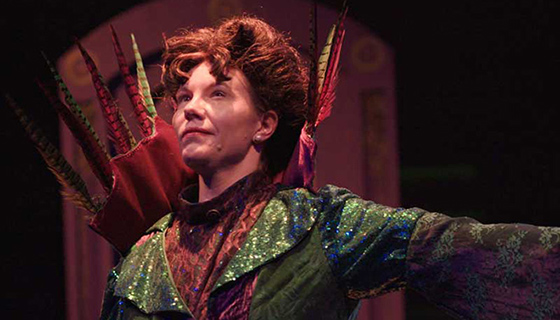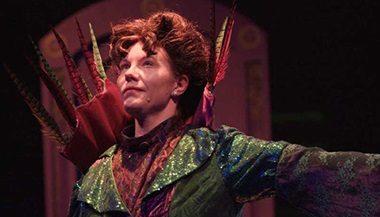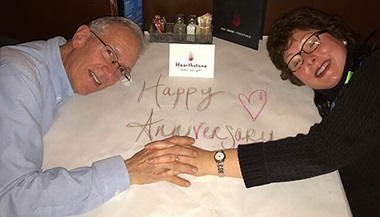Patient Story
Stroke Rehabilitation: Mary’s Story
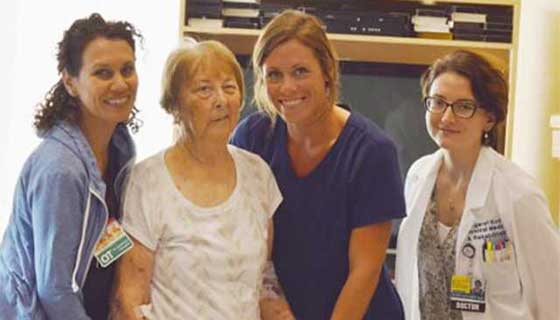
Patient Story Highlights
- Mary Ford, a mother of seven and a grandmother to many more, suffered a stroke that affected the right side of her body.
- She was undergoing rehabilitation at Johns Hopkins when a complication arose: a blood clot in her left leg.
- Thanks to the quick response from the rehabilitation team, the blood clot was addressed and Mary is back on her road to recovery.
From Caregiver to Patient
Having dedicated most of her life to caring for her family, Mary Ford knows a thing or two about good caregiving. She raised seven children with her husband, and later took care of him when he was diagnosed with dementia and Alzheimer’s. Watching him go through his diagnosis and treatment made her nervous about ever having to entrust herself to someone else’s care. So when she was hospitalized for a stroke, Mary felt uneasy about the whole experience.
“When Mom was taken to the hospital, initially she asked us to stay for the night,” says Mary’s daughter Karen. It was difficult for her to be alone in an unfamiliar place. But once Mary and her family got to know the highly trained and caring inpatient rehabilitation team at the Johns Hopkins Bayview Medical Center, their worries went away.
The Road to Recovery
Mary spent several weeks at Johns Hopkins participating in physical, occupational and speech therapy. The stroke affected the right side of her body, making it difficult to stand up, use her hands and even talk.
At 88 years old, Mary is an avid Scrabble player and church choir singer. She knows her way around the iPad. “She loves socializing and loves people,” shares Karen. And even after her stroke, she wasn’t about to give up her favorite things in life.
I know it takes patience; you just have to believe that will you continue to get better.
Mary Ford
An Unexpected Complication
A few days before Mary was to be transferred to subacute rehabilitation, she woke up with pain in her left leg. She had developed a blood clot in her superficial femoral artery that completely blocked the blood flow. Mary was rushed to the operating room, and within hours surgeons removed the blood clot.
It is situations like this when it is important to have a quick transfer from rehabilitation to surgery. Both of these services are in close proximity at Johns Hopkins Bayview. According to Dr. Heitham Hassoun, the attending vascular surgeon who performed Mary’s surgery, arterial blood clot in a leg can be a limb- and life-threatening condition that should be addressed in minutes to hours. “I’d like to commend the rehabilitation team, as well as Dr. Magruder and the rest of our resident physicians, for their quick assessment, preparation of the operating room and response that saved the patient’s leg,” shares Dr. Hassoun.
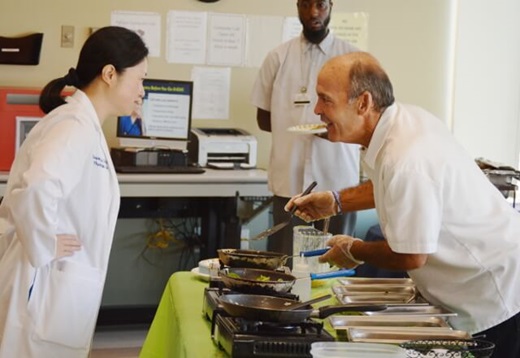
Back to Making Progress
It’s difficult enough to overcome the numerous issues caused by stroke. Having to go through a surgery on top of that was a bit of a setback for Mary. But she was far from giving up.
“I know it takes patience; you just have to believe that you will continue to get better,” says Mary.
“Mary has been making great progress improving her functional performance and overall level of function. We’ve been working to help her with transfers, moving around and activities of daily living,” says Dana Alonzi, one of Mary’s occupational therapists.
Thankful for everything the Johns Hopkins Bayview inpatient rehabilitation team has done for their mother, several of Mary’s children organized an appreciation breakfast for the staff. A part-time caterer, Mary’s son Mark set up a station with fresh omelets made to order, feeding rehabilitation therapists, nurses, physicians and other rehab team members.
“From nurses to housekeeping, everyone on the rehabilitation team was excellent. They made our mom feel comfortable and safe, while helping her get back on her feet,” shares Karen.

